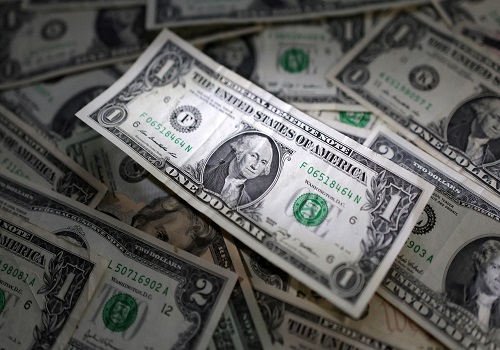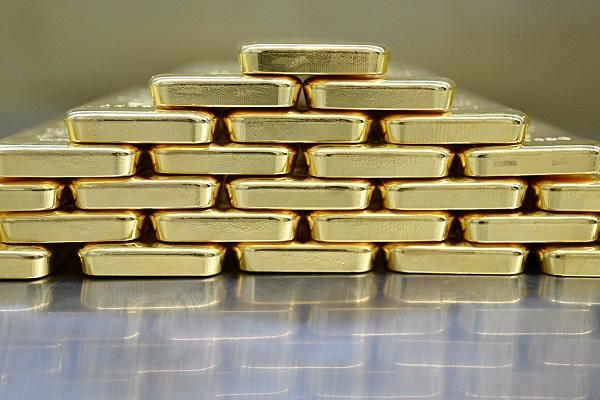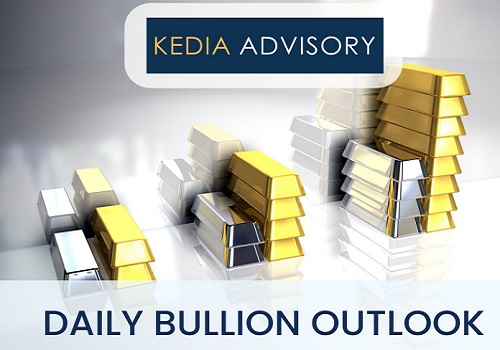Aluminium trading range for the day is 231.6-240.8 - Kedia Advisory

Gold
Gold prices advanced by 0.93% to settle at 96,421, supported by heightened geopolitical and economic uncertainties. Renewed trade tensions triggered safe-haven buying, with President Trump proposing a 50% tariff on European Union imports starting June 1, and threatening Apple with a 25% tariff if it fails to move iPhone production to the U.S. These developments, combined with the passage of Trump’s new tax bill — projected to expand the U.S. fiscal deficit by $3 trillion over the next decade — deepened investor concerns, reinforcing gold’s appeal as a hedge against macroeconomic risks. Additionally, rising geopolitical tensions in the Middle East, particularly around Israel’s potential strike on Iranian nuclear facilities, added to the risk-averse sentiment. However, physical demand in India remained subdued due to high global prices and a weaker rupee, with dealers offering discounts up to $49/oz. In contrast, China maintained firm premiums of $16–$30/oz, signaling continued retail interest. Singapore and Hong Kong traded at par to modest premiums, while Japan saw flat to $1/oz premiums. Globally, gold demand rose 1% YoY to 1,206 metric tons in Q1 2025, driven by a 170% surge in investment demand, including ETF inflows and increased bar buying. Technically, gold is witnessing fresh buying with open interest rising 2.82% to 9,951 contracts. Support lies at 95,800, below which a test of 95,180 is possible. Resistance is seen at 96,795, with a breakout potentially targeting 97,170.
Trading Ideas:
* Gold trading range for the day is 95180-97170.
* Gold climbed as renewed trade tensions fueled risk aversion.
* President Trump proposed a 50% tariff on imports from the European Union starting June 1.
* Support also seen not only by trade concerns but also by growing unease over the US fiscal outlook.
Silver
Silver prices rose by 0.26% to settle at 98,054, supported by safe-haven demand amid renewed geopolitical and economic uncertainties. Investor interest was sparked by fresh tariff threats from U.S. President Donald Trump and a weakening dollar. The U.S. Treasury Department's soft $16 billion 20-year bond auction, combined with the lingering impact of Moody’s downgrade of the U.S. credit rating, further fueled market anxiety. Additionally, Trump’s new tax bill, narrowly passed in the House, and expectations of potential rate cuts later in 2025 by the Federal Reserve, as noted by Governor Christopher Waller, underpinned safe-haven demand for silver. Despite the gains, silver’s upside was capped due to weakness in industrial metals, as U.S. debt concerns weighed on broader manufacturing-sensitive commodities. Still, silver’s long-term fundamentals remain strong. The market is projected to post a significant deficit for the fifth consecutive year in 2025, driven by record-high industrial demand, which is expected to surpass 700 million ounces. The green economy and technological applications will continue to support structural growth in industrial fabrication. Silver physical investment is also forecast to increase by 3%, especially in Europe and North America. Meanwhile, jewelry demand is projected to decline by 6%, with India accounting for most of the drop due to high local prices. Technically, the market is under fresh buying with open interest increasing by 2.11% to 17,149. Silver has support at 97,240, and a break below may test 96,420. Resistance is seen at 98,575, and a move above could push prices toward 99,090.
Trading Ideas:
* Silver trading range for the day is 96420-99090.
* Silver gained amid renewed tariff threats from U.S. President Donald Trump and a weaker dollar.
* US President Trump announced plans to impose 50% tariffs on EU imports starting June 1.
* Fed’s Waller said that the central bank could cut interest rates in the second half of 2025.
Crude oil
Crude oil prices edged down by 0.11% to settle at 5,259, weighed by geopolitical and supply-side concerns. Market sentiment was subdued after U.S. President Donald Trump recommended a 50% tariff on European Union imports, raising fears of trade disruptions. Additionally, growing expectations that OPEC+ will proceed with another output increase of 411,000 barrels per day in July further pressured prices. The OPEC+ meeting scheduled for next week will be closely watched for confirmation of this production hike. Bearish momentum was reinforced by unexpected builds in U.S. crude and fuel inventories. According to the Energy Information Administration (EIA), U.S. crude stocks rose by 1.3 million barrels, contrary to expectations of a drawdown of the same magnitude. Gasoline inventories also increased by 816,000 barrels, versus forecasts for a 520,000-barrel decline, while distillate stocks rose by 580,000 barrels, defying an anticipated drop of 1.4 million barrels. On the demand front, the International Energy Agency (IEA) projected that global oil demand growth will slow to 650,000 bpd for the remainder of 2025, down from 990,000 bpd in Q1. However, the IEA raised its full-year 2025 demand growth forecast slightly to 740,000 bpd due to expectations of stronger economic activity and lower oil prices encouraging consumption. Technically, crude oil is under fresh selling pressure with open interest rising by 1.04% to 11,653. Support is seen at 5,175, and a break below may test 5,092. Resistance lies at 5,315, with further upside potential toward 5,372.
Trading Ideas:
* Crudeoil trading range for the day is 5092-5372.
* Crude oil dropped as U.S. President Donald Trump recommended a 50% tariff on the European Union.
* Pressure also seen amid expectations rose that OPEC+ will increase crude output further in July.
* OPEC+ is holding meetings next week expected to yield another output increase of 411,000 bpd for July.
Natural gas
Natural gas prices rose modestly by 0.14% to settle at 281.3, supported by declining production levels and forecasts for hotter-than-average weather across the Lower 48 U.S. states. The prospect of increased electricity demand to power air conditioning systems is expected to boost consumption from gas-fired power plants, lending strength to prices despite recent storage builds. Production in May slipped to an average of 104.9 billion cubic feet per day (bcfd), down from April’s record 105.8 bcfd. Daily output also dropped to a one-week low of 104.7 bcfd. Meanwhile, U.S. gas stockpiles increased sharply by 120 billion cubic feet for the week ending May 16, the highest weekly build since September 2022 and the largest pre-summer build since 2015. Demand is projected to drop from 99.5 bcfd this week to 96.1 bcfd next week, before rebounding slightly. LNG export activity also moderated in May, with flows to U.S. export terminals slipping to 15.1 bcfd from a record 16.0 bcfd in April. Despite near-term fluctuations, the U.S. Energy Information Administration (EIA) expects both production and consumption to hit record highs in 2025, underscoring strong structural demand growth. Technically, the market is under short covering with open interest dropping sharply by 16.46% to 7,775 contracts. Natural gas finds support at 275.5, with further downside risk to 269.6. Resistance is seen at 286.4, and a breakout could push prices toward 291.4.
Trading Ideas:
* Naturalgas trading range for the day is 269.6-291.4.
* Natural gas gains on a drop in output and forecasts for hotter-than-normal weather.
* Gas stockpiles were currently around 4% above the five-year (2020-2024) average.
* Average gas output in the Lower 48 U.S. states fell to 104.9 bcfd in May.
Copper
Copper prices edged up marginally by 0.08% to settle at 859.9, supported by ongoing supply and inventory dynamics but pressured by concerns over global manufacturing demand. The People’s Bank of China’s recent rate cuts and increased government bond issuance signaled continued support for economic activity, particularly industrial production, providing a modest uplift to copper prices. However, this optimism is tempered by the International Copper Study Group's (ICSG) revised forecast, which doubled the expected copper surplus for 2025 to nearly 300,000 tonnes, reflecting abundant ore supply from South America. Despite weak macroeconomic sentiment, physical market indicators point to a tightening in some regions. Inventories monitored by the Shanghai Futures Exchange (SHFE) declined 9% to 98,671 tons, and LME stocks dropped 8% to 164,725 tons. Meanwhile, U.S. COMEX inventories surged to 174,607 tons, up 61% since late March, as traders redirected global shipments toward the U.S. ahead of possible tariffs under President Trump’s trade policy. Globally, the refined copper market showed a surplus of 61,000 metric tons in February, slightly down from January, according to the ICSG. Consumption reached 2.14 million metric tons against an output of 2.20 million metric tons. Technically, copper is experiencing short covering as open interest fell by 25.79% to 1,729 contracts. Support is seen at 854.5, with further downside potential to 849. Resistance is expected at 863.1, and a breakout could push prices towards 866.2.
Trading Ideas:
* Copper trading range for the day is 849-866.2.
* Copper settled flat as risks to manufacturing demand amplified the impact of ample copper supply.
* Copper inventories in warehouses monitored by the SHFE fell 9% to 98,671 tons.
* Stocks in the LME-registered warehouses lost 8% to 164,725 amid continuing inflows into the COMEX-owned warehouses.
Zinc
Zinc prices declined by 1.02% to settle at 257.8, pressured by ongoing uncertainty surrounding U.S. trade tariffs. Although the U.S. and China agreed to a 90-day truce with reduced tariffs, markets remain cautious due to the lack of clarity on long-term trade relations. This geopolitical ambiguity weighed on sentiment, overshadowing some bullish fundamentals. On the supply side, zinc inventories in Shanghai Futures Exchange-monitored warehouses dropped 4.9% from the previous week, reflecting tightening spot availability due to smelter maintenance activities. However, the broader outlook suggests rising supply ahead. China's refined zinc production in April rose 1.6% month-on-month and around 10% year-on-year, with cumulative output for January to April up only 0.3% YoY, slightly below expectations. The growth was mainly driven by increased production in regions like Gansu, Qinghai, Yunnan, and Sichuan. Meanwhile, zinc treatment charges (TCs) are climbing, and new smelting capacities are expected to contribute to a surplus, with supply likely to outpace demand going forward. On a global scale, the zinc market surplus narrowed to 23,700 metric tons in March from 75,900 tons in February, per ILZSG data, reflecting some near-term tightening. Technically, the market is under long liquidation, indicated by a sharp 40.47% drop in open interest to 790 contracts. Zinc now finds support at 255, with further downside risk to 252.2. Resistance is seen at 260.8, and a move above this level could see prices test 263.8.
Trading Ideas:
* Zinc trading range for the day is 252.2-263.8.
* Zinc dropped amid due to persisting uncertainty over U.S. tariffs.
* The global zinc market surplus fell to 23,700 metric tons in March from 75,900 tons in February
* Zinc inventories in warehouses monitored by SHFE fell 4.9% from last Friday, the exchange said.
Aluminium
Aluminium prices fell by 0.55% to settle at 235.55, pressured by global economic uncertainty and improving supply conditions. Market sentiment weakened amid concerns over the rising U.S. debt burden and a slowing global economic outlook. Adding to the bearish tone, China cut its benchmark lending rates for the first time since October and state-owned banks lowered deposit rates in an effort to support its faltering economy amid simmering trade tensions. On the supply front, global primary aluminium output rose by 2.2% year-on-year in April to 6.033 million tonnes, according to the International Aluminium Institute (IAI). In China, aluminium production reached 3.75 million tonnes in April, marking a 4.2% increase from a year earlier. Cumulatively, China produced 14.79 million tonnes between January and April, up 3.4% year-on-year. While Beijing’s annual cap of 45 million tonnes offers some long-term supply restraint, current figures point to steady output growth. Furthermore, China’s exports of unwrought aluminium and aluminium products grew by 17% in the first ten months of the year, reaching nearly 5.5 million tonnes, further boosting global supply. Additionally, improved alumina availability in Southeast Asia has reduced input costs and eased supply bottlenecks, encouraging stable smelter operations. Technically, the aluminium market is undergoing long liquidation, evidenced by a sharp 27.12% drop in open interest to 1,107 contracts. The metal now finds support at 233.6, with a potential test of 231.6 on further weakness. Resistance is seen at 238.2, and a break above could push prices toward 240.8.
Trading Ideas:
* Aluminium trading range for the day is 231.6-240.8.
* Aluminium dropped amid persistent concerns over global manufacturing and easing supply constraints.
* China cut benchmark lending rates for the first time since October, and major state banks lowered deposit rates.
* Global primary aluminium output in April rose 2.2% year on year to 6.033 million tonnes
Cottoncandy
Cottoncandy futures declined by 0.63% to settle at 53,730 amid profit booking, following prior gains driven by shrinking domestic crop estimates. The Cotton Association of India (CAI) has revised its 2024-25 production forecast downward by 4 lakh bales to 291.30 lakh bales (170 kg each), primarily due to lower output in Maharashtra. Total cotton supply till the end of March is estimated at 306.83 lakh bales, including 25 lakh bales of imports and opening stocks of 30.19 lakh bales. However, stocks at the end of March were pegged at 127.83 lakh bales, of which 100.83 lakh bales are held by trade and government agencies. Notably, exports are expected to decline sharply to 16 lakh bales from 28.36 lakh bales last year, while imports are projected to more than double to 33 lakh bales due to tighter domestic supplies. Globally, the U.S. cotton balance sheet for 2024-25 showed a minor shift, with exports reduced by 100,000 bales and ending stocks increased accordingly. Meanwhile, global production is slightly lower, and textile mill use is down by 520,000 bales due to reduced demand from China and Indonesia. Technically, Cottoncandy is under long liquidation as open interest dropped by 12.84% to 129 contracts. Support lies at 53,670, with further downside potential to 53,610. Resistance is seen at 53,820, and a breakout above could push prices toward 53,910.
Trading Ideas:
* Cottoncandy trading range for the day is 53610-53910.
* Cotton dropped on profit booking after prices gained as CAI expects a shrinkage in crop.
* Cotton exports for the 2024-25 season are pegged at 16 lakh bales, lower by 12.36 lakh bales over previous year’s 28.36 lakh bales.
* The closing stock for 2024-25 season at end of September 2025 is estimated lower at 23.49 lakh bales from same period last year’s 30.19 lakh bales. I
* In Rajkot, a major spot market, the price ended at 25995 Rupees gained by 0.09 percent.
Turmeric
Turmeric futures declined by 0.92% to settle at 14,054, pressured by increased arrivals and subdued export inquiries. Total arrivals surged to approximately 57,500 quintals, nearly doubling from the previous session’s 29,860 quintals. This uptick in supply weighed on prices. However, downside remained limited due to ongoing concerns regarding reduced yields and lower production despite an increase in acreage. The area under turmeric cultivation rose to 3.30 lakh hectares this season—up 10% from last year—but untimely rains and quality issues, especially in regions like Nanded, are expected to curb overall output. Early estimates suggest new crop yields may be 10–15% lower than the previous season’s 10.75 lakh tonnes. In local markets like Duggirala, strong buying interest persists for fresh arrivals, with newer stocks commanding a price premium over older inventory due to better quality. Around 50–55% of the total new crop has already been traded, and with harvesting still ongoing and arrivals projected through June, trading activity is expected to remain robust. Government procurement initiatives in Himachal Pradesh are also contributing to market support. On the export front, turmeric shipments rose 11.51% year-on-year during April–February 2025, totaling 161,229.56 tonnes. Technically, turmeric is under fresh selling pressure as open interest increased by 0.94% to 16,030 contracts while prices dropped by 130. Immediate support is seen at 13,952, with a break below likely testing 13,848. On the upside, resistance is at 14,190, and a move above this could open the path toward 14,324.
Trading Ideas:
* Turmeric trading range for the day is 13848-14324.
* Turmeric dropped due to increased arrivals and owing to weak export enquiries.
* However downside seen limited amid persistent concerns about lower production estimates.
* Yields expected 10–15% lower; Nanded region hit by crop rot and small rhizomes
* In Nizamabad, a major spot market, the price ended at 14489.95 Rupees dropped by -0.44 percent.
Jeera
Jeera futures settled higher by 1.49% at 21,060 despite subdued export demand and limited buying from domestic buyers. The rise was largely attributed to short covering amid the conclusion of the retail season and inactivity from foreign buyers. However, the market remains pressured by comfortable supplies and weak export interest due to adequate existing stocks. Total arrivals in key mandis increased to 32,900 bags from 28,000 bags in the previous session, intensifying supply-side pressure. Adding to the cautious sentiment, the sowing of the new cumin crop in major producing states like Gujarat and Rajasthan has been delayed by about a month due to unfavorable weather conditions. Farmers reportedly hold around 20 lakh bags of cumin, with only 3-4 lakh bags expected to be traded by the season’s end, leaving a substantial carry-forward stock of approximately 16 lakh bags. On the export front, jeera shipments between April and February 2025 surged 62.55% to 195,164.58 tonnes compared to the same period last year. However, exports in February 2025 fell by 23.92% month-on-month to 12,996.88 tonnes. Imports for the period dropped significantly by 93.70%, indicating reduced reliance on external supplies. Technically, the market is undergoing short covering with open interest declining by 3.5% to 6,363 contracts while prices gained 310. Immediate support is seen at 20,820, with a break below potentially testing 20,560. Resistance is placed at 21,230, and a sustained move above this level could push prices toward 21,380.
Trading Ideas:
* Jeera trading range for the day is 20560-21380.
* Jeera gained due to lower buying despite weak export demand.
* The current season is expected to have similar production levels as last year due to better crop conditions.
* In Feb 2025 around 12,996.88 tonnes of jeera were exported as against 17,083.31 tonnes in Jan 2025 showing a drop of 23.92%.
* In Unjha, a major spot market, the price ended at 21269.1 Rupees dropped by -0.28 percent.
Views express by all participants are for information & academic purpose only. Kindly read disclaimer before referring below views
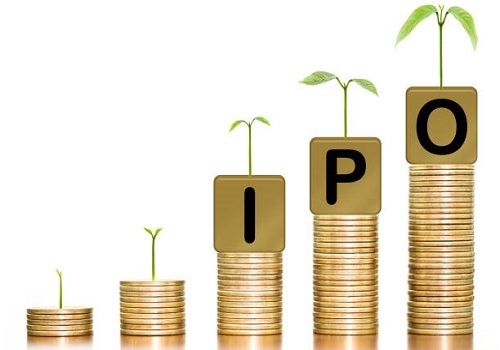
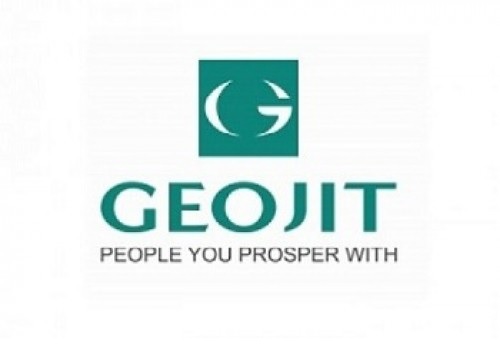
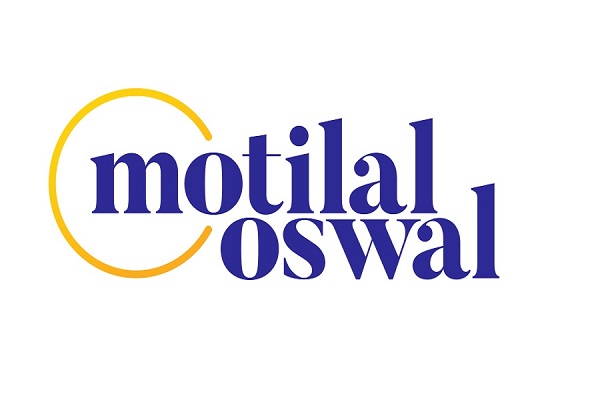

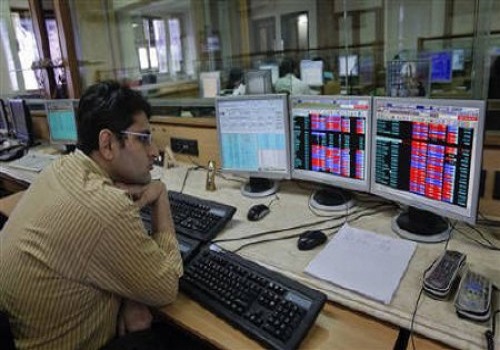
.jpg)


